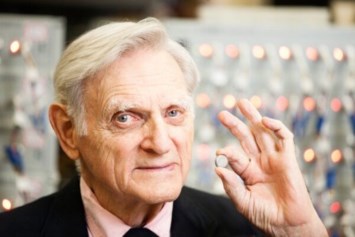
OBITUARY
John B Goodenough
25 July, 1922 – 25 June, 2023

On December 10, 2019, in the Stockholm Concert Hall, King Carl XVI Gustav of Sweden in a reversal of roles for a royal, bowed before 97-year-old John Bannister Goodenough, who was using a wheelchair after recent hip surgery. Around Goodenough’s collar he placed the gold medal signifying the award of the Nobel Prize in Chemistry for developing the rechargeable lithium-ion battery. Goodenough is the oldest person to receive the Nobel Prize. Dr. Goodenough died on June 25, 2023, exactly one month short of his 101st birthday. He was an active technical contributor to the further development of batteries at The University of Texas at Austin until the last few weeks of his life.
Goodenough was born on July 25, 1922, in Germany to Edwin Ramsdell Goodenough and Helen Goodenough. He grew up in rural Connecticut, north of Yale University, where his father was a professor. As a young man he attended the Foote School in New Haven, Conn. In 1934, he was admitted to the Groton School, from which he graduated in 1940 Magna Cum Laude, with the top grade in his class. He entered Yale University in 1940 and graduated in 1944 with a degree in mathematics, Suma Cum Laude. At Yale, he was a member of Skull and Bones. He served in the U.S. army during World War II. He attended the University of Chicago, earning a Ph.D. in physics in 1952.
Goodenough began his career at the Massachusetts Institute of Technology’s Lincoln Laboratory in 1952, where he worked for 24 years and helped lay the groundwork for the development of random-access memory (RAM) for the digital computer. In 1955, while at MIT, he developed his first major contribution to science when he formulated fundamental principles of magnetism, now known as the Goodenough-Kanamori Rule. Following MIT, Goodenough became professor and head of the Inorganic Chemistry Laboratory at St. Catherine’s College at the University of Oxford. During this time, he developed the underlying technology for a stable Lithium-Ion battery.
He came to UT Austin in 1986, setting out to develop the next battery breakthrough and educate the next battery innovators. He held the Virginia H. Cockrell Centennial Chair in the Cockrell School of Engineering where he taught for 37 years.
The three most influential people in his life were Endicott Peabody who was a surrogate father to him at Groton School. From him he learned about the fundamentals of the Christian faith, the love of God, and a phrase he treasured and repeated often, “Help us, O Lord so long as we live to live nobly and to the good cheer of our fellow man.” After World War II, Dr. Egbert Miles, his math professor at Yale, was instrumental in obtaining a U.S. Army fellowship for him to study physics at the University of Chicago. There he met his wife, Irene Wiseman. She organized a study that would lead him to embrace Christianity. For Irene, he would write a poem on her birthday and at Christmas. He used the writing of poetry to overcome his dyslexia.
His book, Witness to Grace, was published in 2008. In it he tells his life’s story, professional journey, and Christian pilgrimage. He presented a copy of the book to the Nobel Prize Library in 2019.
He is survived by his sister, Ursula W. Goodenough (Professor of Biology Emerita at Washington University in St. Louis) and a brother, Daniel A. Goodenough (Takeda Professor of Cell Biology, Emeritus, Harvard Medical School), and by close associates Lucy Zhu, Ram Manthiram, Jianshi Zhou, John Halton, and Hadi Khani and his wife, Isal Kalami both of whom gave loving care to Dr. Goodenough during the last years of his life.
A memorial service is scheduled for Friday, June 30 at 9:00 a.m. at St. Matthews Episcopal Church at 8134 Mesa Drive in Austin. A private burial beside his beloved wife will follow later.
UT Austin has more on Dr. Goodenough and his life’s accomplishments here: https://news.utexas.edu/2023/06/26/ut-mourns-lithium-ion-battery-inventor-and-nobel-prize-recipient-john-goodenough/
UT Austin Provost Sharon Wood’s comments are here: https://t.e2ma.net/message/n4fhri/zltc2fk
And more information about the memorial service and the ability to contribute a story about Goodenough or photos are available on the Weed Corley Fish website at: https://www.dignitymemorial.com/obituaries/austin-tx/john-goodenough-11347023
St. Matthew’s Livestream is at: https://www.youtube.com/@StMattsAustinVirtual/streams
Memorial contributions may be made to St. Matthew’s Episcopal Church, the Salvation Army, or John B. and Irene W. Goodenough Endowed Research Fund in Engineering or the Irene W. Goodenough Endowed Presidential Scholarship in Nursing, both at The University of Texas at Austin.
Fond memories and expressions of sympathy may be shared at www.wcfishnorth.com for the Goodenough family.
Show your support
Add a Memory
Share Obituary
Get Reminders
Services
SHARE OBITUARYSHARE
- GET REMINDERS
v.1.11.6